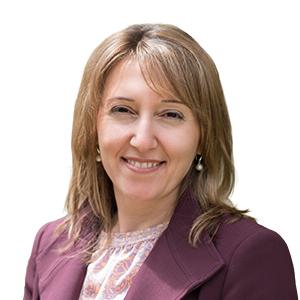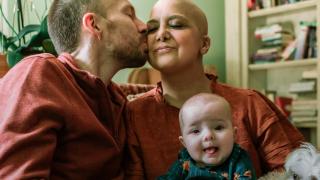It can be a double blow: a cancer battle made all the more frightening by a case of COVID-19.
Since the pandemic began, many patients have faced this dual challenge: navigating the uncertainties of their personal cancer journeys while simultaneously coping with the new threats created by the coronavirus.
“I’ve already had 10 such patients,” said Erminia Massarelli, M.D., Ph.D., M.S., co-director of City of Hope’s Lung Cancer and Thoracic Oncology Program.
Among them, Jessica Sherrie.
In April 2020 Sherrie, a sketch comedy actor from Glendora, California, gave birth to Regina, a delightful baby girl. During pregnancy, Sherrie experienced “intense” back pain, which she learned was not that unusual in the third trimester.
However, instead of diminishing after birth, the pain got worse. Sherrie also became weak, and her cognitive abilities began to decline. That’s when she and husband Alec realized something was wrong, though her original doctors were slow to detect it.
“One CT scan was unclear,” recalled Alec. “Then there was an MRI with no follow-up. We waited for more than a month.”
The bad news came on Sherrie’s 34th birthday: EGFR-positive lung cancer, and it had spread: a “golf ball-sized tumor” in her brain, other tumors in her spine and pelvis.
EGFR+ cancer is triggered by a defect in the epidermal growth factor receptor, found in both normal and cancer cells. The mutation leaves the receptor stuck in the “on” position, causing uncontrolled growth. EGFR+ cancer occurs mostly in women and primarily among nonsmokers.
Fortunately, chemotherapy and several targeted therapies, known as EGFR inhibitors, have shown remarkable results. Though when Sherrie heard “lung cancer,” all she felt was fear.
“It threw me for a loop,” she said. “I was terrified. Both my in-laws died of lung cancer. I was thinking the worst.”
Sherrie began radiation treatment for the brain tumor, but her condition was deteriorating rapidly. Her father called a friend who worked at City of Hope and urged his daughter to visit the place he called “the best of the best.”

By the time she reached Massarelli’s office, Sherrie was in a wheelchair, and in such mental decline she could not speak nor fully comprehend conversations (for that reason, City of Hope waived its COVID-19-related visitor ban, allowing Alec to stay with her.)
“She was on the brink of death,” recalled Massarelli.
But no one in the room was giving up.
“At first I thought to myself, ‘God help us, this will be tough,’” Massarelli remembered.
“But I never lose hope. I’ve treated other patients like Jessica, and I’ve witnessed miracles made possible by drugs that target EGFR mutations. It can truly be a ‘Lazarus effect’” — when a patient thought to be lost is brought all the way back to health.
“I had faith I was going to live,” said Sherrie, whose positive attitude was well known to her family. Early on, when one doctor began talking about “quality of life,” implying Sherrie might not survive very long, Sherrie’s mom cut him off. “No!” she said. “My daughter wants to fight through this!” Too weak to speak, Sherrie gave a thumbs up.
The Sherrie family liked Massarelli immediately.
“We got along really well,” said Sherrie. “She really knew what she was doing, and I knew I was getting the best care from one of City of Hope’s top doctors.”
Plus there was the common bond of motherhood.
“Being a mom myself, I understand how determined she was to live for her daughter,” Massarelli said.
There would be many setbacks. Treatment with the EGFR inhibitor Tagrisso had to be stopped when Sherrie developed lung inflammation, a rare side effect that put her in the hospital for weeks. She was switched to chemotherapy. Then, as she began rehab to start walking again, Sherrie tumbled and broke her hip. Six more weeks in the wheelchair as she convalesced.
Then, on New Year’s Eve, Sherrie tested positive for COVID-19.
Though it was a mild case (“Two days,” she said. “Like a cold.”), it could not be ignored, and this is where Sherrie benefited from many months of hard work, painstaking precautions and invaluable experience gained by the patient safety specialists at City of Hope.
When the pandemic began, City of Hope responded quickly, transforming the Duarte campus, as much as possible, into a COVID-19-free zone, safe for patients and staff alike. From masks to temperature checks to virus testing to keeping visitors and patients’ families away, City of Hope held employee-to-employee virus transmission to near zero, and didn’t have a single case of patients infecting staff.
As COVID-19 persisted and surrounding hospitals filled beyond capacity, City of Hope inevitably had to deal with “water flowing over the dam” — a growing number of infected people.
By now, though, care options had grown as well.
“Initially, if someone got [mild] COVID-19, we would wait until they tested negative to admit them” because there wasn’t much the hospital could do, explained Tyler Seto, M.D., vice president of enterprise quality and patient safety. “But now with the different antibody treatments, we can help these patients. And we have places to safely do it.”
The Duarte campus maintains dedicated — and properly isolated — inpatient and outpatient COVID-19 treatment units, run by staff who focus exclusively on these patients. The units grow and contracts as the need for them changes. City of Hope hired additional people to accommodate these new needs, rather than draw staff away from other units.
“We never took anything away from cancer care,” Seto stressed.
Things have only improved with the arrival of the COVID-19 vaccines. City of Hope implemented an aggressive plan to vaccinate staff as quickly as possible. “It’s one little layer of extra protection,” said Seto, “but it’s also meant a lot less anxiety.”
Everything was in place to treat Sherrie when COVID-19 struck. She received bamlanivimab, an antibody treatment currently authorized for emergency use by the Food and Drug Administration. It worked well. Meanwhile, she continued her chemo, which is also working, along with physical therapy. As a result, Sherrie was finally able to walk into her most recent follow-up exam, and when Massarelli told her the tumors were shrinking, “she gave me a big hug,” said Sherrie, smiling.
The Sherries’ story carries a double message.
First, perhaps most important: the care is still there.
“We haven’t stopped providing excellent cancer care, despite COVID-19,” Massarelli said. She’s concerned that people fearing infection may delay diagnosis or treatment. Fight that fear. “Call us right away.”
Second: attitude matters.
“Stay positive, don’t give up,” said Sherrie. “I know that the fact I was so determined helped me.” She admits to having more than a few bad days, but she urges, “Do what you can to overcome your fears.”
The Sherries are planning ahead should Sherrie’s tumors begin to grow again. Sherrie is currently undergoing genetic testing to determine if she has any other mutations — information that could be useful down the road if her chemo stops working and another targeted therapy can be identified. Plus, she’s ready for newer treatments in development, should they become necessary.
And of course, there’s nothing like a new addition to the family to really change your outlook.
“When you have Regina to consider, things really start to matter,” Sherrie said.
“She’s worth fighting for.”
